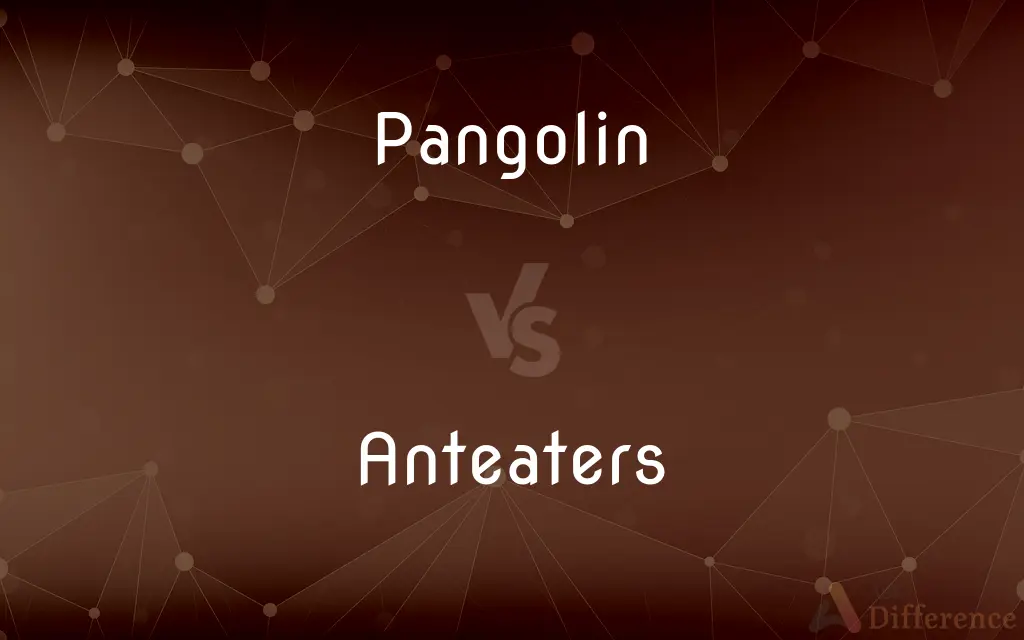Pangolin vs. Anteaters — What's the Difference?
Edited by Tayyaba Rehman — By Fiza Rafique — Updated on November 3, 2023
Pangolins are scaly, insect-eating mammals found in Asia and Africa, while anteaters are scale-less and found in the Americas.

Difference Between Pangolin and Anteaters
Table of Contents
ADVERTISEMENT
Key Differences
Pangolins are unique mammals known for their full-body protective scales made of keratin. These creatures are found primarily in Asia and Africa. Anteaters, in contrast, have no scales but possess a thick fur coat and are native to Central and South America. Both pangolins and anteaters feed primarily on ants and termites, but the way they capture and consume their prey differs due to their physical characteristics.
The physical form of a pangolin is distinctive, with a conical head and a long, prehensile tail that aids in climbing and balance. An anteater’s physique is characterized by a stout body, an elongated snout, and a long, bushy tail. While anteaters use their sharp claws primarily for digging into ant colonies, pangolins use theirs for both digging and defense, curling into a ball when threatened.
Pangolins are solitary animals, meeting only to mate and are largely nocturnal. Anteaters can be diurnal or nocturnal depending on the species. In terms of reproduction, pangolins give birth to one offspring at a time, while some anteater species can give birth to twins. The maternal care in pangolins involves carrying their young on their tails, whereas anteaters carry their offspring on their backs.
When it comes to conservation status, many pangolin species are critically endangered, mainly due to poaching for their scales and meat. Anteaters also face threats from habitat loss and hunting, but not to the same extent as pangolins. Efforts to protect pangolins include international trade bans, while anteater conservation focuses on habitat preservation.
Both pangolins and anteaters play a significant role in their ecosystems as pest controllers. However, pangolins are more closely related to carnivores and have a more specialized diet compared to anteaters. The pangolin's diet is almost exclusively ants and termites, while some anteater species also consume fruit and soft-bodied grubs, showing a slight variation in their dietary habits.
ADVERTISEMENT
Comparison Chart
Native Habitat
Asia and Africa
Central and South America
Body Covering
Scales made of keratin
Fur without scales
Tail
Prehensile, often used for climbing
Large and bushy, non-prehensile
Conservation Status
Many species critically endangered
Varied, some species less threatened
Social Behavior
Solitary, except for mating
Mostly solitary, some species less so
Dietary Adaptations
Specialized in ants and termites
Consumes ants, termites, and sometimes fruit
Compare with Definitions
Pangolin
Pangolins are characterized by their unique keratin scales that cover their bodies.
Conservationists are working to protect the endangered pangolin species.
Anteaters
An anteater is a mammal that primarily consumes ants and termites using its long snout.
The anteater used its snout to forage for food in the underbrush.
Pangolin
These mammals use their long, sticky tongues to capture their insect prey.
The pangolin extended its tongue to catch ants from a mound.
Anteaters
Anteaters are recognized by their elongated heads and bushy tails.
An anteater’s bushy tail can be used for balance and warmth.
Pangolin
The pangolin is known for its ability to roll into a ball as a defense mechanism.
The predator was unable to harm the pangolin once it rolled up tightly.
Anteaters
They possess strong claws for digging into insect nests and climbing trees.
The anteater effortlessly tore into the termite mound with its claws.
Pangolin
A pangolin is a scaly, nocturnal mammal that feeds on ants and termites.
A pangolin curled into a ball to protect itself from predators.
Anteaters
These animals are found throughout the grasslands and forests of the Americas.
Anteaters are a common sight in the South American savanna.
Pangolin
Pangolins are solitary creatures, often found in forests and grasslands.
I was lucky to spot a solitary pangolin during my safari in Africa.
Anteaters
Anteaters can range from small, tree-dwelling species to large, ground-foraging ones.
The giant anteater is one of the most impressive sights in the Amazon.
Pangolin
Pangolins, sometimes known as scaly anteaters, are mammals of the order Pholidota (, from Ancient Greek ϕολιδωτός - "clad in scales"). The one extant family, the Manidae, has three genera: Manis, Phataginus, and Smutsia.
Anteaters
Any of several Central and South American mammals of the suborder Vermilingua that lack teeth and feed on ants and termites, especially the giant anteater.
Pangolin
An African and Asian mammal that has a body covered with horny overlapping scales, a small head with an elongated snout, a long sticky tongue for catching ants and termites, and a tapering tail.
Anteaters
Any of several other animals, including the echidna, aardvark, and pangolin, that feed on ants.
Pangolin
Any of several long-tailed, scale-covered mammals of the order Pholidota of tropical Africa and Asia, having a long snout and a sticky tongue for catching and eating ants and termites. Also called scaly anteater.
Anteaters
Plural of anteater
Pangolin
The scaly anteater; any of several long-tailed, scale-covered mammals of the order Pholidota of tropical Africa and Asia, the sole extant genus of which is Manis.
Pangolin
Any one of several species of Manis, Pholidotus, and related genera, found in Africa and Asia. They are covered with imbricated scales, and feed upon ants. Called also scaly ant-eater.
Pangolin
Toothless mammal of southern Africa and Asia having a body covered with horny scales and a long snout for feeding on ants and termites
Common Curiosities
What do pangolins eat?
Pangolins primarily eat ants and termites.
How do anteaters consume food?
Anteaters use their long tongues to lap up ants and termites.
What is a pangolin?
A pangolin is a scaly insectivorous mammal native to parts of Asia and Africa.
Are pangolins related to anteaters?
No, despite similar diets, pangolins are not closely related to anteaters.
Can anteaters be domesticated?
No, anteaters are wild animals and are not suitable for domestication.
Are anteaters found in Africa?
No, anteaters are native to Central and South America, not Africa.
Do pangolins have teeth?
No, pangolins do not have teeth; they ingest small stones to help grind their food.
What is the biggest threat to pangolins?
The biggest threat to pangolins is illegal poaching for their scales and meat.
How many species of pangolin are there?
There are eight known species of pangolins.
Do anteaters have good eyesight?
No, anteaters generally have poor eyesight but have a keen sense of smell.
Do pangolins live in trees?
Some pangolin species are arboreal, living in trees, while others are terrestrial.
Are pangolins endangered?
Yes, all pangolin species are listed under some level of threat, with several critically endangered.
Can pangolins swim?
Yes, some pangolin species are capable swimmers.
What is the largest species of anteater?
The giant anteater is the largest species of anteater.
How long is an anteater's tongue?
An anteater's tongue can be up to 2 feet long, depending on the species.
Share Your Discovery

Previous Comparison
Scepticism vs. Skepticism
Next Comparison
Evaluatee vs. EvaluandAuthor Spotlight
Written by
Fiza RafiqueFiza Rafique is a skilled content writer at AskDifference.com, where she meticulously refines and enhances written pieces. Drawing from her vast editorial expertise, Fiza ensures clarity, accuracy, and precision in every article. Passionate about language, she continually seeks to elevate the quality of content for readers worldwide.
Edited by
Tayyaba RehmanTayyaba Rehman is a distinguished writer, currently serving as a primary contributor to askdifference.com. As a researcher in semantics and etymology, Tayyaba's passion for the complexity of languages and their distinctions has found a perfect home on the platform. Tayyaba delves into the intricacies of language, distinguishing between commonly confused words and phrases, thereby providing clarity for readers worldwide.
















































